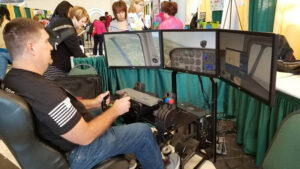
Educators were hungry for hands-on activities for the classroom at the 5th annual STEM/STEAM Forum in Athens, Georgia. Gleim Aviation was there to help teachers and administrators learn how to use our resources to kickstart STEM Aviation programs in schools. Teachers took to flying the Gleim Virtual Cockpit before deciding if it was right for their class. We had a blast showing off the simulator and our library of pilot training materials with this group, and it was clear they had even more fun learning to fly!
The National Science Foundation raised awareness in the early 2000s about the need for STEM, that is, classes that integrate science, technology, engineering and mathematics principles. More recently, attention turned to aviation because learning to fly truly blends each STEM focus area. In July, we published a helpful article about the benefits of STEM Aviation for education (check it out here if you missed it).
Even though STEM is a well-established concept, schools and academies across the nation have many options to choose from to best integrate STEM. Aviation is a great choice because students who are learning about advanced math and physics can see real-world scenarios pan out through flight simulation in school. Additionally, having the ability to start a career directly out of high school is possible for students who earn a pilot’s license. They can practice flying and understand complex topics in ways that are fun and interactive without ever leaving the ground. Not to mention using a flight simulator is very affordable and can expedite flight training in an airplane.

Last year Gleim attended the AOPA STEM Symposium. This event is hosted by the Aircraft Owners and Pilots Association and is part of the You Can Fly program. As stated on the AOPA website, “AOPA has identified a gap in aviation youth education that no other organization is filling. By working with high schools directly, we are helping to expose a diverse group of students to aviation that might otherwise never realize that a career as a pilot or in a drone-related field is completely within reach.”
Gleim is attending the 2018 AOPA STEM Symposium in Louisville, Kentucky, November 5-6, because it is a great place to connect with teachers and industry leaders who are interested in furthering STEM Aviation education. Schools with established programs and those that are just starting a class or club dedicated to aviation can benefit from the knowledge sharing and resources offered. Additionally, seasoned pilots can play a critical role by partnering with local STEM Aviation programs to talk to students about their journeys and maybe take students up for a plane ride.

We understand that most teachers and administrators are unsure where to start! Gleim has heard directly from many different schools and educators, and we want to answer a few frequently asked questions leading up to this year’s STEM Symposium. We are creating new materials for teachers each week, so make sure to stop by our booth or visit our dedicated STEM Resource Hub Online for more information.
Here are a few common questions we encounter:
Q. How does Gleim help schools? Anything we can to help! Gleim Aviation has been producing pilot training resources for nearly 40 years. Traditionally, these resources have been used by individuals and flight schools to help people pass more than one million FAA exams as they realize their dream of becoming a pilot. Now that schools are adding aviation, our materials can easily be modified to fit the timeline for an academic year. We have people who are here to help in any way, and we are constantly upgrading our products to fit current needs. This year we will be adding many free resources designed with teachers in mind so they can easily utilize any of our materials.
Q. What grade is right for adding aviation? We have seen that schools at the elementary, middle, and high school levels have found added value by offering students the opportunity to use a flight simulator. Whether used as a reward for 4th and 5th graders to recognize good behavior, to spark a passion to learn more about how planes/drones fly in middle school, or to better grasp physics and science principles in high school while teaching a skill that prepares students for a job, early exposure is needed for students who want to become pilots.
Students can earn a private pilot’s license at age 17 and fly a plane solo at age 16. They can become certified drone pilots at age 16 and take the sUAS or drone course up to two years prior to their 16th birthday, then officially receive their license at 16.
Q. What skills does a teacher need to instruct aviation? Teachers are often encouraged or required by their schools to receive professional development training. For aviation, you can become certified to teach ground school as a Basic or Advanced Ground Instructor in about 30-35 hours and for less than $300. Teachers can also become licensed drone pilots, allowing them to supervise students’ drone flying. Either course will help anyone become a subject matter expert in aviation for the classroom!
We would love to learn more about your school’s aviation goals and help you build a custom plan to fit your needs. Other questions we can help answer include:
- How can we get funding?
- What can other students do while someone is using a simulator?
- How can I start an aviation program at my local school?
Our team has years of diverse aviation experience as flight instructors, airline pilots, corporate pilots, military pilots, maintenance technicians, aircraft inspectors, and more. Please contact our Aviation Training Consultants to learn more about how we can support your STEM Aviation needs at 800.874.5346, x471, or contact us online.
About Gleim Aviation
Since 1980, Gleim Aviation’s team of pilots, instructors, writers, designers, and programmers has helped aviators pass millions of FAA knowledge and practical tests using the unique Gleim Knowledge Transfer System. Gleim is an environmentally-friendly company headquartered in Gainesville, FL.

